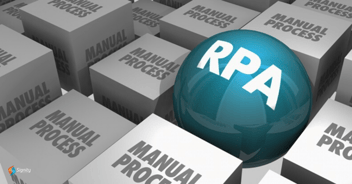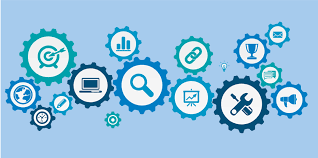Top 8 Automation Trends: Find Where Automation is Accelerating in 2023
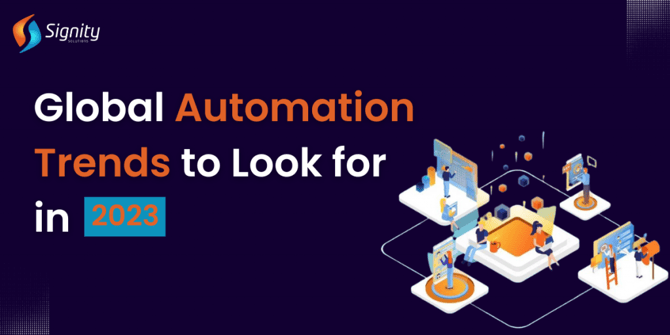
IT Automation Trends have historically been written by the core goals of IT Operations.
Undoubtedly, the COVID-19 epidemic has disrupted the way we shop, work, and access services. In response, enterprise-level organizations continue to inch towards digital-first business models and cloud-native operations in 2022, with big implications for IT automation trends.
Simply put, automation allows more scalable, agile, and effective control of an extensive array of integration use cases, resulting in more valuable insights and efficient operations.
As organizations automate their processes, they get more clarity, stability, and secure innovation, in the face of pandemic disruptions and other headwinds.
Furthermore, the expeditiously growing competition between companies and increasing interest in improving business productivity is becoming more crucial than ever.
And this is where Robotic Process Automation comes into the big picture. Since RPA's debut in the early 2000s, its potential has outgrown to curate a prominent position in the enterprise technology mix and act as a strategic lever for digital transformation.
Know how industries are taking advantage of RPA - Read Here!
Unquestionably, RPA (Robotic Process Automation) is one of the significant tech evolutions in the automation landscape.
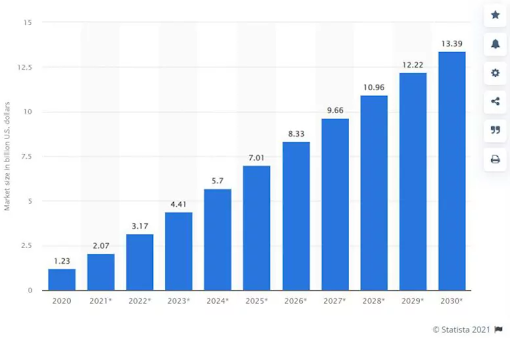
Beisdes, the RPA market is growing exponentially and is predicted to grow ~13.4 billion by 2030, which is an increase of 12 billion compared to 2020. Also, the expecting organizations and businesses to automate all their processes, trusted RPA vendors are offering a complete suite of bells and whistles.
In the wake of the pandemic, the market had witnessed a bite-sized appetite for a change instead of the whole buffet, though:
“The Global RPA market is predicted to rise over the projected horizon during the coming period, between 2022 and 2026.”
Furthermore, organizations across different sectors are integrating RPA and trends in AI to uphold productivity and efficiency. After all, to thrive in today’s competitive market, it’s imperative to improve work agility and deliver enhanced customer experiences.
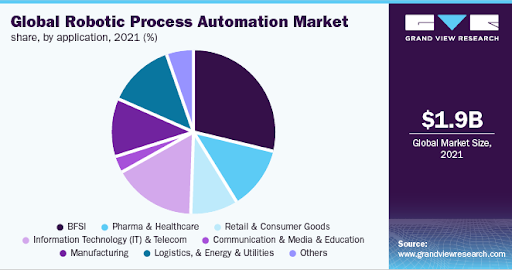
This is where RPA comes to the forefront.
But, what’s more, important is that the epidemic did not mar the adoption sentiment; instead, RPA adoption has significantly contributed to mitigating business disruptions because of COVID-19.
Here are some RPA use cases that are leveraged by the industry leaders.
More importantly, the RPA adoption will help companies keep employees engaged and efficient, further adding to RPA’s merit. But, from a business perspective, the most pressing question is, “What does the future hold for RPA”?
What Innovations Are Expected in RPA Trends?
Let’s take a look at the automation crystal ball to outline a handful of forward-looking trends in RPA that are soon to become a reality in 2023 and ahead.
Let’s start!
Embracing Intelligent RPA
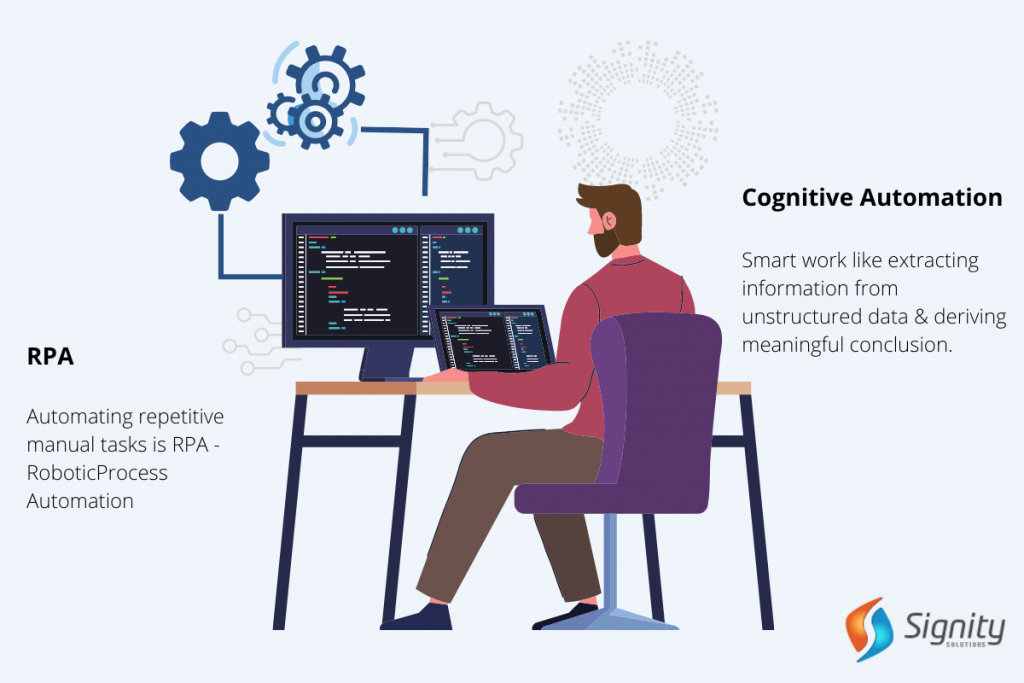
There’s no doubt that cognitive RPA brings intelligence into the equation.
Thanks to recent advancements in Machine Learning (ML) and AI (Artificial Intelligence), process automation evolved from a mere screen-scraping technology with bots handling voluminous tasks to more cognitive technology.
This level of cognition is achieved thanks to the data training gathered with the data from data annotation processes.
Cognitive RPA, popularly known as Intelligent RPA, refers to augmenting RPA tools with AI and ML capabilities like NLP (Natural Language Processing), Optical Character Recognition (OCR), and Deep Learning. Also, cognitive RPA allows businesses to automate repetitive, rule-based tasks and predictions and forecasts rooted in structured and unstructured data.
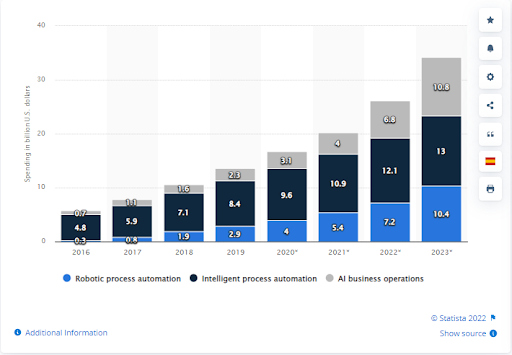
It’s expected that RPA and Intelligent process automation operations will gain significant traction in 2023.
Furthermore, in the Deloitte report, organizations have stated that:
- Intelligent RPA has already exceeded its expectations by 16-26%.
- They expect to achieve increased productivity and cost reduction, more accuracy, and an unparalleled customer experience.
RPA As Center Of Excellence
With myriad RPA automatable tasks varying across different business functions like HR, IT to Customer Service, more and more businesses are moving towards migrating their RPA functions to a single Center Of Excellence to manage all RPA-related tasks.
To be precise, RPA CoE is a centralized business unit responsible for deploying, scaling, and maintaining RPA solutions across different business areas. It enables employees of different skills and levels to innovate, improve, scale, and measure the success of RPA solutions.
An RPA CoE includes an RPA strategy leader - either a company employee with experience in RPA projects or a trusted RPA consultant.
“Low-Code Platform” Is The New In Robotic Process Automation Trend
RPA + LOW CODE = BETTER TOGETHER
Low-code can develop complete databases and deliver applications to IT. In contrast, RPA tools take on tasks at the “human” level, portraying that RPA tools focus on mimicking repetitive, human interactions that are easy to automate.
It’s easy to establish and forget, but the maintenance involved is exponential to get the most out of these tools. And, here, RPA and Low-Code come to the rescue to deliver complete hyper-automation.
So, to have a robust digital transformation strategy, it’s imperative to identify the potential of these tools working together for the organization.
Not to forget, organizations are trending towards the idea of complete hyper-automation as they embark on their digital journey. Undoubtedly, RPA and Low-Code platforms are an unskippable part of that equation.
Automating Cybersecurity With RPA
Organizations must understand that cybersecurity is more complicated than ever and that not having the proper defenses can be catastrophic. But on the other hand, hiring more people and investing significant capital expenditures in the latest security hardware and software is not realistic for most organizations.
Rather, businesses and companies find great operational and financial value in integrating RPA into their cybersecurity defense framework. Besides, RPA enables IT and business leaders to design more in-depth and layered protection, identify the source of an attack, secure it and remediate its impact more quickly and easily.
Automation is an effective and efficient approach to prevent downtime, secure employees and customers, thwart intellectual property theft, and ignore expensive compliance violations.
Here are some pocketed ways in which RPA can extend your cybersecurity defences:
- Decrease human error and limit unauthorized access
- Fill inevitable gaps of disparate, legacy systems
- Accelerate the identification of looming threats before they hit
Widespread RPA Adoption In SMEs
SMEs (Small and Medium-sized Enterprises) have realized the potential of RPA solutions to thrive in the competition as the world emerges to the realities of a post-pandemic world.
So, to be precise, this year could witness more SMEs adopting RPA to streamline their business processes and address the labor shortage and manifold output. According to a Deloitte survey, 73% of business executives said that they have already stepped on the path of intelligent automation.
Especially for SMEs, deploying RPA leads to faster turnaround times for streamlined business operations. Also, it’s highly scalable.
Moreover, establishing RPA enhances the service quality as it minimizes human error that results in inconsistent result delivery. RPA also offers SMEs comprehensive intelligence and actionable information, proving to be a goldmine for better insights.
RPA Will Be The “HEART” & “SOUL” Of Automation
In 2022, Robotic Process Automation will unfurl its wings as the heart and soul of how businesses start to integrate their automation systems.
Wondering, how?
Simple RPA technology allows computer robots or “bots” to learn and perform repetitive and voluminous tasks, like filling out forms, processing paperwork, and many more freeing up valuable employee work hours.
Often, businesses and organizations implement RPA first to streamline their workflows, saving time and money. Besides, RPA technology integrates with complex automation systems, including intelligent document processing (IDP) and Artificial Intelligence. For example, businesses can establish RPA to process order forms and deliver and also integrate AI features to recommend products to customers.
Precisely, in 2022, RPA will get the lion's share on platforms that need a richer user interface and higher levels of AI by allowing companies to integrate RPA into their already existing processes easily and use it to manage their existing technologies.
“Cloud Native RPA” Skyrockets to Fuel Epidemic Recovery
In simple terms, it means RPA-as-a-service.
It is defined as automation software that’s easy to access and use for anyone with an internet connection, on any device that deploys and orchestrates processes and workflows across the organization.
According to Everest Group, “the market for cloud-based application modernization is predicted to grow between 19 to 21% in 2022. And RPA is no exception to this transformation”.
In addition, cloud-based automation platforms e.g. document automation tools are also designed for automation self-service, with intuitive drag-and-drop actions and visual flow charts empowering non-techie teams to automate on their own. Cloud RPA allows users to automate any process through a web-based interface accessed in their browser.
RPA-focused MSPs
Because of RPA adoption cost and extended time to solution roll-out, organizations switch to Managed Service Providers (MSPs) that provide RPA as a service to outsource their automation tasks. Besides, MSPs can deliver businesses with automation capabilities without requiring any RPA infrastructure or training at a reduced cost in a short time.
Thus, it’s expected more IT-oriented MSPs will offer RPA as one of their main services.
These were some wholly new RPA trends that you shouldn’t skip. But, more IT automation trends can drive significant disruption and opportunity over the next 5 to 10 years.
Other Notable IT Automation Trends That You Should Not Miss!
Let’s have a look!
Cloud-Native Platforms - Goodbye to “lift and Shift” Migrations
To deliver digital potential anywhere and everywhere, enterprises should abide bye to the earlier known “lift and shift” migrations towards cloud-native platforms. CNPs use the core capabilities of cloud computing to offer scalable and elastic IT-related capabilities “as a service” to technology creators through internet technologies, delivering it quicker with reduced costs.
For this reason:
Gartner predicted that cloud-native platforms will cater as the foundation for more than 95% of new digital initiatives by 2025.
“Autonomic Systems” is the New In
Traditional programming or just automation will not pace up with the growth of an enterprise. Here, the autonomic system comes into the picture.
Autonomic systems are self-managing physical or software systems that learn from environments. Unlike autonomous systems, autonomic systems can dynamically alter their own algorithms without any external update, enabling them to quickly adapt to new conditions in the field, the same as humans.
A reminder: Autonomic behaviour has already made itself known through recent deployments in complicated security environments, but in the long run, it’ll be familiar in robots, drones, smart spaces, and many more.
“Decision Intelligence” - Improving the Decision-Making Process
Undoubtedly, an organization's decision-making competency is a significant source of competitive advantage, but it's becoming a little more demanding.
Overall, decision intelligence is a practical discipline used to improve decision-making by explicitly understanding and engineering how decisions are taken, and results are evaluated, managed, and improved by feedback.
Gartner estimated that in the next two years, one-third of big organizations would use decision intelligence for structured decision-making to improve competitive advantage.
Composable Applications - Master the Accelerated Change
The demand for business adaptability directs organizations towards technology architecture that braces fast, secure, and efficient application changes.
Here, composable application architecture is quick-fix as it empowers adaptability.
“The one that has already adopted a composable approach will outgrow the competition by 80% in the speed of new feature implementation”.
Modern organizations are on the brink of losing their market momentum and customer loyalty without composable application architecture.
“Hyperautomation” is Here to Stay
Hyperautomation allows accelerated growth and business resilience by quickly identifying, vetting, and automating as many processes as possible.
According to Gartner, hyper-automation teams focus on three key priorities:
- Improving the quality of work
- Accelerating business processes
- Enhancing the agility of decision-making
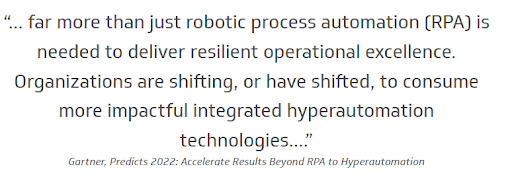
“Privacy-Enhancing Computation” (PEC) - Evolving CIOs Role
Working with maturing international privacy and data protection legislation, CIOs should avoid any loss related to customer trust resulting from privacy incidents. Thus, Gartner estimated that 60% of big organizations will use one or more privacy-enhancing computation techniques by 2025.
These are PEC techniques - protecting personal and sensitive information at a data, software, or hardware level, securely sharing and analyzing data without compromising confidentiality or privacy concerns. Presently, use cases exist in several domains and public cloud infrastructure, for example, trusted execution environments.
“Cybersecurity Mesh” Trust It
Data is the hanging fruit throughout many of the year’s automation trends but is only beneficial if enterprises can trust it and use it.
Though assets and users can be present anywhere, portraying the traditional security perimeter is a thing of the past. This eventually leads to the need for a cybersecurity mesh architecture (CSMA). Cybersecurity mesh offers an integrated security structure and posture to safeguard all assets despite location.
Besides, it’s predicted by 2024, organizations adopting a CSMA to establish security tools to work as a cooperative ecosystem will minimize the financial impact of individual security incidents by 90%.
“Total Experience (TX)” - A Complete Business Strategy
As the term suggests, Total Experience (TX) is a business strategy that blends the discipline of customer experience (CX), employee experience (EX), user experience (UX), and multi-experience (MX).
The core objective of total experience is to bring unparalleled customer and employee confidence, satisfaction, loyalty, and advocacy. As a result, organizations are indeed ready to harness the increased revenue and profit by achieving adaptive and resilient TX business outcomes.
Finally, Stepping Towards the Future of Automation.
But, if you are still sitting on the fence about “Why Automation,”?
To Increase Your Competitiveness.
There’s no doubt that the COVID-19 epidemic has caused a significant disruption in how organizations operate. Besides, it’s been a tremendous year, and in many different ways, CIOs and IT teams have risen to the occasion and delivered beyond expectations.
Therefore, capitalizing on the future of automation technologies will bring huge waves in today’s economy as it reduces costs and work and simultaneously improves the total experience.
Planning automation for your business? And why not? Implementing automation in processes entails more innovative businesses.
Get in touch with industry experts at Signity solutions that dwell with years of experience in automation. Our skilled and trained professionals will assist you through the complete journey of successfully incorporating automation, ensuring efficiency and better ROI.
Frequently Asked Questions
How digital technology affects the future?
Digital technologies have advanced more rapidly than any innovation in our history – reaching approximately 50 percent of the developing world's population in merely two decades and transforming societies. So, technology can be a great equalizer by enhancing connectivity, financial inclusion, and access to trade and public services.
What is digital transformation in the IT industry?
Digital transformation is the process of utilizing digital technologies to create new — or alter present — business processes, culture, and customer experiences to address changing business and market requirements. This reimagining of business in the digital age is digital transformation.
What are the upcoming opportunities in the digital world?
Five emerging hot trends that will continue to shape the digital world in the coming. They are as follows:
- Democratization of technology. Democratization of technology is about making technology accessible to more people.
- Hyper-automation.
- Multichannel experience.
- Information safety.
- Human Augmentation.
What are the key trends in digital transformation in 2022?
The Top 2022 Digital Transformation Trends from intelligent technologies such as artificial intelligence (AI) and machine learning (ML) to cloud-based platforms, these trends are already affecting how businesses interact with customers and each other.
What are emerging trends in automation?
The forerunner technologies like artificial intelligence (AI), machine learning (ML), cloud services and the Internet of Things (IoT) are powering everything from robotics to augmented reality (AR) and virtual reality (VR) for businesses in these industries, and are considered the emerging trends in automation.
Which RPA tool is in demand?
UiPath is a leader in the RPA market, surpassing Microsoft in this market. The company executed well and is expected to grow at a 25% CAGR from 2021 to 2023. Besides, for the fourth consecutive year, Gartner has recognized UiPath as a Magic Quadrant Leader in robotic process automation (RPA). And as a certified UiPath partner, Signity empowers its customers with intelligent bots that can automate several business processes.


%201-1.webp)


.png?width=344&height=101&name=Mask%20group%20(5).png)








